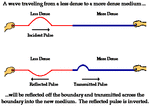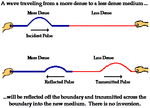CHL
Member level 3


(https://www.physicsclassroom.com/class/waves/Lesson-3/Boundary-Behavior)
Hello
As you can see above, when a wave meets a different impedance, it is reflected.
If the load impedance is higher, the phase is inverted, but if the load impedance is lower, the phase is not inverted.
However, according to the reflection coefficient equation,
(ZL-Z0)/(ZL+Z0)
when the ZL is higher, the phase should not be inverted. Also when the ZL is smaller, the phase should be inverted.
This is a totally opposite way
What is wrong with these??